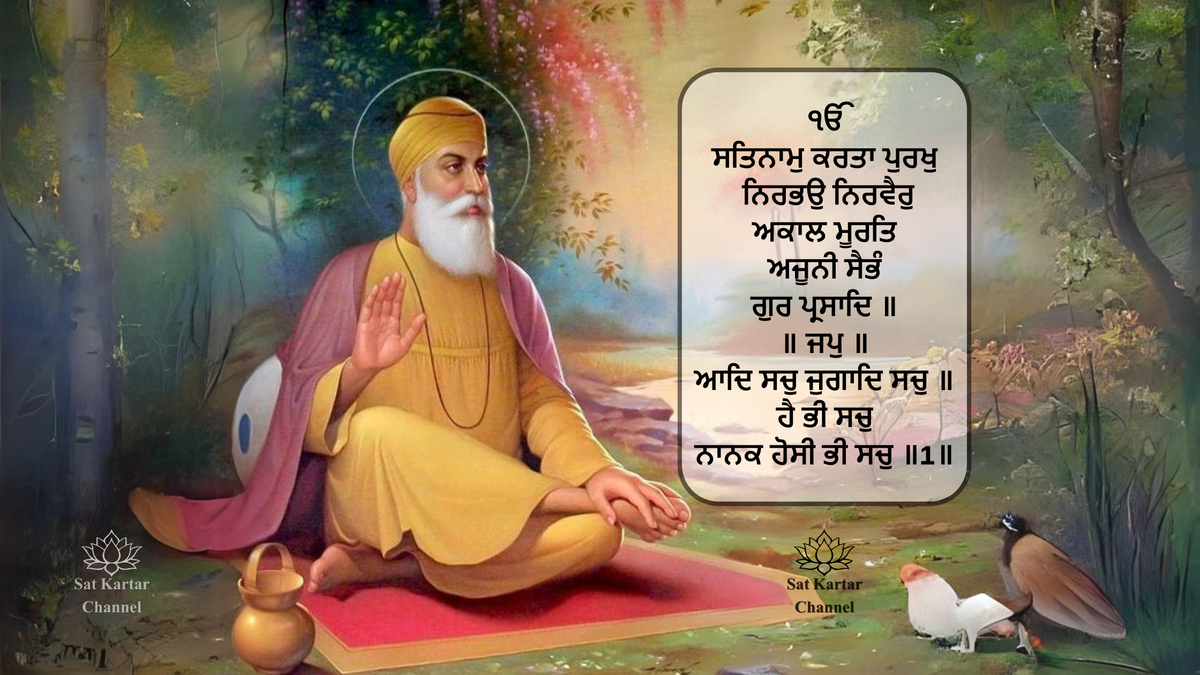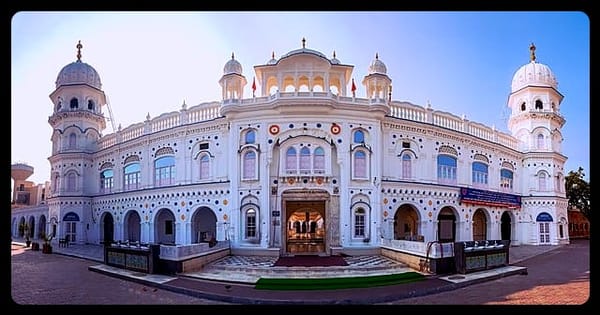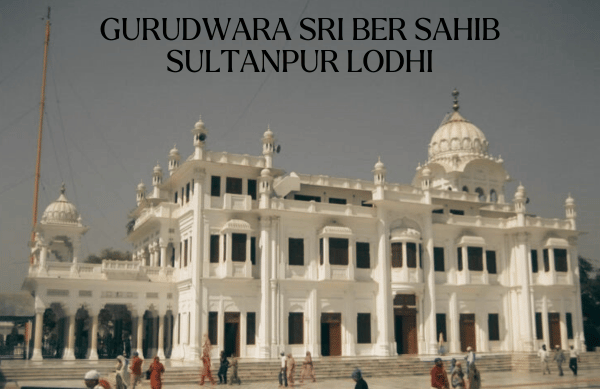Guru Nanak Dev Ji
Guru Nanak Dev Ji who is the first sikh guru & also the founder of sikhism. Know more about life, marriage, enlightenment, journey and teachings of Baba Nanak.

Guru Nanak, also known by the name of Baba Nanak was the founder of Sikhi (Sikhism) and is the first of the 10 Sikh Gurus.
BIRTH OF GURU NANAK
Guru Nanak Dev Ji was born on 15th April, 1469 at Rai-Bhoi-Di-Talwandi , which is situated near Lahore, in the Punjab province of Pakistan. The village is now known as Nanakana Sahib. Baba Nanak's father Mehta Kalu ji was an accountant and his mother Mata Tripta ji was a very pious women. He also had an elder sister Bebe Nanki ji who later on became the first Gursikh. Guru Nanak’s birth was seen as a blessing.

EARLY LIFE OF GURU NANAK
From a young age, it was clear that Nanak was not an ordinary child. Unlike other children, he displayed a profound interest in spirituality and often questioned the practices and beliefs that divided people. His kindness and curiosity set him apart, and even as a child, he spent hours meditating, lost in thoughts of the divine. Local villagers would often observe the young boy in quiet reflection, sensing that he had a deep connection to something far beyond their understanding.
As Guru Nanak grew older, his wisdom and compassion only deepened. The stories of his early years are filled with miraculous events and insights that foreshadowed his future as a spiritual leader. One day, while grazing cattle, Nanak fell into a meditative trance. The cattle roamed freely into the fields, but instead of being angered, the villagers were captivated by the sight of the young Nanak radiating a peaceful aura as he sat in prayer.
Another significant moment came when Nanak was asked to spend money wisely by his father. Given a few coins, he was instructed to make a profitable trade. Instead, Nanak encountered hungry saints and used the money to feed them, calling it a “Sacha Sauda.” These early stories embody Guru Nanak’s teachings, emphasizing selflessness, equality, and devotion to the One Creator.
From the stories of his childhood, it was quite evident that Guru Nanak Dev ji was blessed with an inquiring and contemplative mind. He used to question the age old traditions and would often speak out against these rituals fearlessly. We all have heard about the story where young Nanak ji denied wearing Janeu. He thought rationally and would surprise his teachers with the sublimity of his wisdom especially on spiritual matters. He became fluent in multiple languages like Sanskrit, Persian, Hindi. By the age of 16, Guru Nanak Sahib moved to Sultanpur. Baba Nanak's elder sister Bebe Nanki resided at Sultanpur after her marriage to Jai Ram. Guru Nanak started working at modikhana but there also he had no interest in mundane realities of life.

On 24 September 1487, Guru Nanak Dev ji got married to Mata Sulakhni ji, in the town of Batala. After their marriage, they lived at Sultanpur and Mata Sulakhni gave birth to two sons - Shri Chand & Lakhmi Das. During Guru Nanak's stay at Sultanpur Lodhi, everyday before the sunrise, he used to go to river Kali Bein and after taking bath he would meditate for long hours. During the daytime, he used to continue doing his job at modikhana. He used to meditate everyday under the tree for 14 years, 9 months & 13 days. Even today, a huge tree (beri) is present at Gurudwara Beri Sahib.
GURU NANAK'S ENCOUNTER WITH THE DIVINE
As per the Janam sakhi, during one of those mornings, as per his routine, when Guru Nanak went to take bath in the river Kali Bein, he had a direct communion with the divine. He disappeared from the river stream and was not seen for 3 days. He reappeared at a spot 3 miles away. The first words uttered by Guru Nanak were "No one is Hindu, no one is Musalman". Gurudwara Sant Ghat is situated at the site where Guru Nanak Dev ji emerged after 3 days. It was at Gurudwara Sant Ghat Sahib, where Guru Nanak Dev ji revealed Mool Mantar for the very first time. Guru Nanak Sahib was now ready to preach the message of Oneness to the entire world.
After attaining enlightenment, somewhere around the age of 30 years, Guru Nanak Dev ji resigned from his job at modikhana as he prepared himself to travel in four directions and spread the real message of God. For this cause, he left his family under the care of his elder sister Bebe Nanki.

THE UDASIS OF GURU NANAK
Along with his companion Bhai Mardana & Bhai Bala, Guru Nanak Dev Ji travelled more than 28000 kms on foot. Here is a brief summary of the places visited by Guru Nanak Patshah ji.
1) FIRST UDASI (1499AD - 1506AD) - The first udasi or the 1st spiritual journey lasted for 7 years and Guru Nanak Sahib covered the following regions - Sultanpur, Bhatinda, Sialkot, Saidpur, Tolumba, Panipat, Delhi, Varanasi, Nanakmata (Nainital), Tanda Vanjara, Banaras, Gaya, Kamrup, Shillong, Manipur, Sylhet, Dhaka, Calcutta, Cuttack and Jagan Nath Puri. By the end of pehli (first) udasi, Guru Nanak ji was around 37 years old.
2) SECOND UDASI (1506AD - 1513AD) - Dooji udasi or second udasi lasted for 7 years. Places covered by Guru Nanak Dev ji were Khandwa, Nanded, Bidar, Junagarh, Somnath, Dwarka, Sri Lanka, Batticaloa, Sita Eliya, Kataragama and Matiakalam. By the end of second udasi, Guru Nanak Sahib was around 44 years old.
3) THIRD UDASI (1514AD - 1518AD) - Regions covered by Guru Nanak Dev ji during third udasi were Kashmir, Leh, Lhasa, Mount Sumeru, Kathmandu, Sikkim, Tibet & Tashkand.
4) FOURTH UDASI (1519AD-1521AD) - Fourth udasi lasted for 3 years and the regions covered by Guru Nanak Dev ji were Mecca & the Arab countries. By the end of 4th udasi, Guru Sahib's age was around 52 years old.
5) FIFTH UDASI (1523AD-1524AD) - The last or the fifth udasi lasted for about two years Baba Nanak covered places within Punjab.
SETTLEMENT AT KARTARPUR
After his five udasis, Guru Nanak founded Kartarpur (means city of Kartar or Creator) on the bank of river Ravi. He settled down with his family at Kartarpur. Guru Nanak Dev ji donned the clothes of a farmer, started a small farm and ploughed it himself. This was an example set by him to earn one's own honest living (Kirat Karo). He introduced the concept of Langar (free communal kitchen), that would serve all who came, irrespective of caste, creed or gender. In a very short span of time, Kartarpur grew in size & importance. People used to come from near & far off places to seek his blessings and the congregation grew larger day by day. By preaching, Baba Nanak devoted his last 18-20 years of his life to shape the first community of Sikhi.

In the year 1539, Guru Nanak Dev ji appointed Bhai Lehna as his successor and renamed him as Guru Angad (Angad means one's very own). As per Sikh hagiography, as the devotees sensed that their master is soon going to leave the world, there was tension between hindus, sikhs & muslims as to how will the funeral be conducted. The Hindus & Sikhs wanted to cremate him as per their customs and the muslims wanted to bury his body. So all these communities approached Guru Nanak ji to settle this dispute. Guru Nanak Dev ji explained the concept of joti jot to them. Joti jot means that the physical body will expire and the light or the jot would pass on to Guru Angad Dev ji. He asked them to fetch some fresh flowers and instructed the hindus & sikhs to place the flowers on the right side of his body and the muslims to place the flowers on the left side of his body. Guru Sahib said that after his departure, the permission for conducting funeral shall be decided by whichever side of flowers remained fresh. After a small prayer session, Baba Nanak asked the people to get a sheet of cloth and cover his body and leave it till next morning. Guru Nanak Dev ji left his physical body on 22nd September 1539 at Kartarpur. When people from three communities gathered next morning and removed the sheet of the cloth covering his mortal body, they were amazed to find a heap of fresh flowers all over. Guru Nanak Dev ji's body was never found.
The Hindus & Sikhs cremated the flowers while the muslims buried those flowers. Today, Gurudwara Kartarpur Sahib is present on the banks of river Ravi, marks the final resting place of Guru Nanak Dev ji. This gurudwara is visible from Dehra Baba Nanak that is situated in Punjab, India. Alongwith Janamasthan Gurudwara Nankana Sahib & Harmandir Sahib (Amritsar), Gurudwara Kartarpur Sahib is one of the holiest sites for the Sikh community.
Quotes by Guru Nanak Dev Ji
TEACHINGS OF GURU NANAK
1. ONE GOD (EK ONKAR) - Baba Nanak emphasized that there is only One God that is formless, eternal and omnipresent. He rejected the worshipping of idols and fake superstitions followed by people during that period.
2. NAAM JAPO - If you look at the whole life of Guru Nanak Dev ji, you will find that he used to keep God in his conciousness at all times. All his conversations, stories (sakhis) would ultimately lead to the Kartar (Creator). This is one of his important teachings that one should constantly recite Lord's name. Naam Japna is one the pillars of sikhism and is very essential because it will help you in controlling the 5 evils (kaam, krodh, lobh, moh, ahankar) and you will lead a satisfying life.
3) SEWA - Guru Nanak Dev ji believed in Sewa or Selfless service to all beings of this creation, irrespective of caste, creed, gender or social status. When Guru Nanak started the institution of Langar, all the people from different communities sat in a queue and had meals together.
4) HUMILITY - Humility means being free from any pride or arrogance. Humility is a virtue central to Sikhi and is known as nimarta or gareebi. Guru Nanak Dev ji stressed upon the importance of living a simple & modest life. Though being so popular among the masses at that time, he considered himself to be a servant of God.
5) KIRAT KARNI - Kirat Karni is the second pillar of sikhism and is an important teaching of Guru Nanak. He strongly advocated to earn an honest living through hard work, labor & ethical means. After 5 spiritual journeys, when Baba Nanak settled at Kartarpur, instead of getting retired, he himself, started a farm and used to cultivate & plough the land.
6) SARBAT DA BHALA - Sarbat da bhala means wellness for all. Guru Nanak ji firmly believed in universal brotherhood and goodwill for all beings.
7) VAND CHAKNA - Vand Chakna is one of the three pillars of sikhism. It means that we should share, what we have, with others in need. Vand ke chakna is one of the essential teachings of Guru Nanak, that encourages love & compassion within the community. Guru Granth Sahib ji (Ang 1245) says that - "One who works for what he eats, and gives some of what he has, Says Nanak, he knows the path."

LEGACY OF GURU NANAK
Guru Nanak ji has left a rich legacy and millions of people around the world continue to get inspired by his life & teachings. He lived a life of devotion, of a householder, of humility, of love & compassion, of sharing and has shown us the way to God. He has shown us that even in our daily lives doing our jobs, we should meditate on God during Amritvela (ambrosial hours). Guru Nanak proclaimed that anyone could directly commune with God, no intermediaries or no human gurus are required. As the founder of Sikhism, Guru Nanak Dev ji contributed 974 poetic hymns to Guru Granth Sahib ji, which are recited by sikhs with utmost love and devotion with some of the major prayers being Japji Sahib, Asa di War & Sidh Gosht. All his life by spreading the message of Ek Onkar (ੴ or Ik Onkar or Ik Oankaar), Guru Nanak Dev ji has setup a unique doctrine known as Sikhi which is based on oneness, devotion, equality, service, compassion & good virtues.




